THEORIES ABOUND.
| Attribution: |
THEORIES ABOUND.
| Attribution: |
| “Gill-birds make nice pies” | |||
| When I came across this photograph amongst the museum's collection, I found it quite amazing and intriguing, It had me wondering what this scene was all about. It shows a very well dressed man in a three-piece suit with his watch chain neatly hanging from the waistcoat, white shoes and hat holding a string of dead birds in the main street of Huskisson outside the Federal Villa, (where Angels Cafe is located today). The car has a driver and other well-dressed passengers with suitcases tied to the running board. Why is this man holding a string of dead birds? Where are they going? What has he been doing? I had to try and find out. 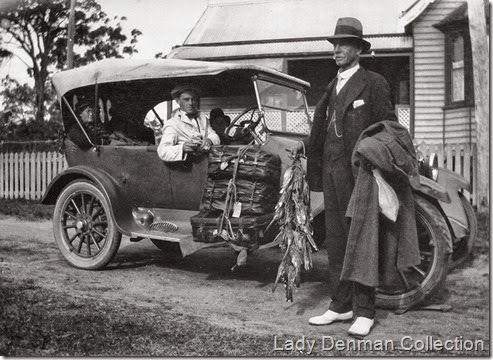 I searched our records, but couldn't find anything more, I then started looking at old newspaper articles that had any content regarding bird hunting and finally came across the article below. “Outdoor Australia” with the subheading “Winter Sport at Jervis Bay.”1912, Sydney Mail | |||
| |||
|
| |||
| “Gill - Birds, in this case, turned out to be a species better know as the Wattlebird. They're known for their queer almost human call, suppose to be “Polly, be careful, Pickpocket.” is rather appropriate, as they are great fruit thieves, though also insectivorous.” | |||
 | ||||||
| The Chindera | ||||||
| On Saturday morning the 10th of September 1895, the twin screw, timber steamer “Chindera”, was launched into the calm waters of Currambene Creek Jervis Bay, by ship builder Mr. G, W. Hardman, who was one of the shipbuilders working along the shores of Currambene Creek Huskisson in the late 1800’s, along side the Dent family of ship builders. Specially built for the Tweed River passenger and cargo trade for the Nicoll’s Line, the new steamer was built exceptionally strong and will carry 180 tons on a easy draught. | ||||||
| Saturday 29th November 1895. Trial trip goes well. After being fitted out the Chindera made her trial trip with Mr. Nicoll and a large party of friends and recorded a speed of over nine knots, which was considered highly satisfactory. The Chindera is nicely fitted up for passengers, and on Saturday afternoon dressed in bunting from deck to masthead, she looked extremely smart. | ||||||
| Wednesday 9th September 1896 Chindera aground on the Tweed Heads Bar. Almost exactly 12 months after her celebrated launch, the Chindera was aground on the Tweed River spit just inside the bar. First Report’s of the disaster.
William Aksel Williamson, seaman on the Chindara, stated he served about 2 and a half months in the vessel. | ||||||
| ||||||
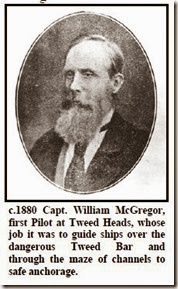 Mr William Mc’Gregor, harbour pilot’s evidence. Mr William Mc’Gregor, harbour pilot’s evidence.Sourced from Community based heritage study - Tweed Shire Council | ||||||
| ||||||
The board found that the loss of the vessel was due to the wrongful act or default of the master in entering when the “stand off” signals were flying, and sited him to appear on Monday to show cause why his certificate should not be suspended of cancelled. After reading certificates as to character, the board decided to suspend Pearson’s foreign going certificate for a period of three months. Pearson applied for a first mate’s certificate, which was granted to him. | ||||||
Chindera a danger to navigation.
| ||||||
Chindera to be blow up.
370lb of dynamite used. The steamer Chindera was successfully blown up yesterday. It was intended to explode three mines of 250lb each of dynamite, but the strong tide running and the sea breaking over the vessel prevented more than one charge of 370lb from being placed under her keel. The charge was fired electronically. The debris was thrown a distance of about 60ft, and the centre and fore part of the hull disappeared. The end of another vessel built built at Huskisson. | ||||||
| Vessels Specs. Chindera - 186 tons. Lbd: 118' x 20'8" x 9'7". Wooden steamship of 35 horsepower, 2 masts schooner rigged, Built by H Hardman. | ||||||
| “Stand off” As I have been researching these stories involving ships wrecked trying to enter a harbour or river mouth, I keep coming across a reference to the “stand off signal flag” being displayed by harbour pilots, as a warning signal to ship captains, - do not enter the harbour or cross the bar until otherwise advised. I thought it would be good to have an image of the flag to go along with this story, I thought with a bit of work Id find the image easily, but that wasn’t the case. Despite extensive research, at this time I'm unable to find an image or for that matter any reference to the words “Stand off” signal at all, the closest international signal is the one below meaning, “you should stop your vessel instantly”  It seems flags that were flying then, may not be in existence now, or may have a different meaning, the research continues. Id like to thank Tony Burton from Flags Australia and Andrew Brown from the Naval Reserve, for their assistance. | ||||||
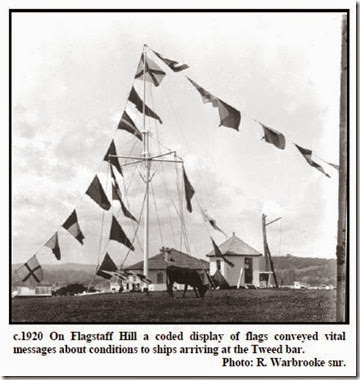 Sourced from Community based heritage study - Tweed Shire Council | ||||||
| The most important signal for the masters of vessels approaching the port was to convey information about the state of the tide. McGregor devised a system of flags to show whether the tide was flooding or ebbing. Then he needed to convey to the vessel if it was safe to cross the bar. In rough conditions he would fly a ‘stand off’ flag signal, to warn the vessel to anchor, usually in Danger Bay, under the lee of Point Danger headland. Sourced from Community based heritage study - Tweed Shire Council | ||||||
| Andrew Brown’s continued input. 28th Jan 2015 The ‘stand off’ signal would have been flown from or very close to the Tweed Heads Signal Station near, but not necessarily at, Point Danger (they would know the location). There is probably a record up there of the specific signal it use to fly - don’t be surprised if the one referred to in the report as ’the stand off signal” is not in fact called the ‘stand off’ signal. It might well be described as ‘Harbour Closed’, 'Bar Heavy’ or similar as ‘stand off’ is a bit too generic. |
 |
In May 1908 a party of fishermen from Sydney and Wollongong were exploring the shores of Jervis Bay and happened upon a long forgotten grave, beneath the mound of which rests the remains of one who passed away long years ago. |
A campers thoughts as he stood beside the grave.
| “I thought of the man, who’s remains lie beneath the mound on the hillside, and of what strange chance drew him from out of this world to be buried in this wild but beautiful place. As I stood trying to solve the impossible, so far as the unknown was concerned, the clear ring of the bell from the camp drew my attention to the fact that breakfast was ready and resolving in my mind I would try to solve the problem of the mound on the hillside”. |
| “The day that our party left Jervis Bay, I learned from one of the oldest residents of the Jervis Bay district some facts regarding the lonely grave on the southern side of the bay”. ”Some thirty-two years ago.” to use the words of my informant, “on a wild bleak night in the month of June, the man who rests in the lonely grave on the south side of the bay came to the settlement. He came alone, and it was evident from the small amount of luggage that he bought, that he came the journey on foot. In the morning, following the night that he came to the settlement, he purchased a boat, a tent, and some camping articles, and made his way across the bay to a place close to the position in which he is now buried. Now and again he would come to the settlement for the purpose of procuring flour and other commodities, but he came and went always in the same silent way, as if something was weighing heavily on his mind. After a time we missed his visits to the settlement, and one day – about a year from the time he came to the bay – a man who had been prospecting the country on the south side of the bay bought the news that a man was dead in his tent on the edge of the bay some ten miles from the settlement. We reported the case to the authorities and he was buried close to the tent where he had lived his lonely life. We bought his tent back as well as a few other things he had with him, but there was nothing to tell us who he was, of where he came from.” |
“Did he have any letters or books in his possession?” I asked.
| “No! Only one small book with a brown back, and some writing in front, which I will show you sir,” he said. I took the book from his hand, and on the turned down page I read - |
| -------------------------------------------------------------- |
| -------------------------------------------------------------- |
| ”I closed the book with a brown back, inscribed on the front page with the wisdom of the old philosophers, and a leaf turned down: yet in the folding of that leaf, and the inscription on it’s front page, what a world of trouble and sorrow it conveyed! ‘' I saw a man in the prime of his life, battling with the conditions of life that surrounded him; cast in a mould very different from the men amongst whom he labored there came a time in this strange mans life when the tie which held him to the place of his boyhood was broken, and he moved out into the world seeking for a place to rest, and he found the needed rest. When most of us in camp were small, ever little children, this strange man of chance came to this place to find the rest for which he craved during his troubled life. Here it is that for thirty long years the mornings sun rising over the cliffs of Cape St George has covered the silent grave in golden glory. A grave where rests the remains of one of those strange human beings who may be correctly termed as misunderstood. The image appearing in this story is a reconstruction, at this time, no image exists of the actual grave site.  |
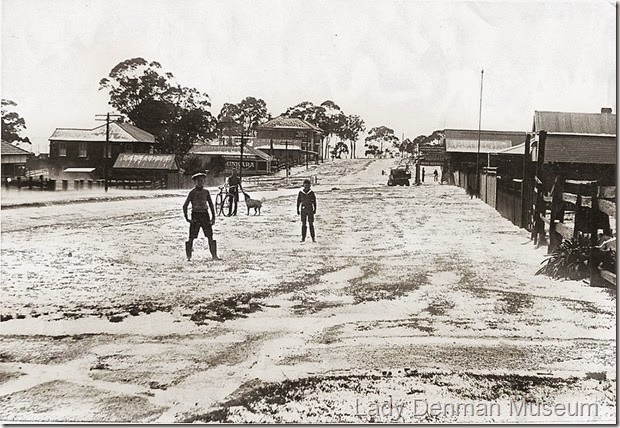
|
Canberra Times. |
The Sydney Morning Herald. 1938
During the storm people locked themselves in their houses, and not a living thing was to be seen in the open. |
| October 1937 – Nowra Leader |
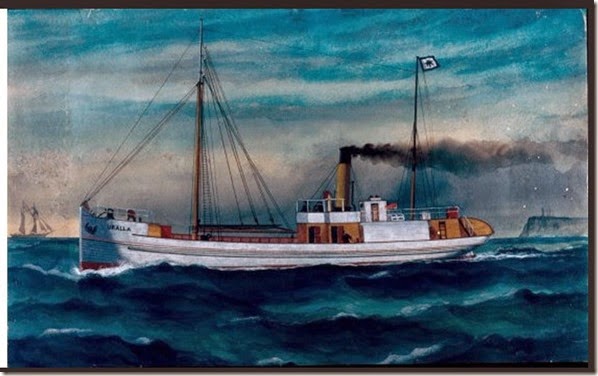 |
| Water colour of the Uralla, renamed the Tilba attributed to George Fredrick Junior (1857 – 1913) |
The notorious area of coast known as Wreck Bay claims another vessel. The Tilba, formally the “Uralla” A 200 ton, twin screwed steamer, built by Denis Sullivan at Coopernook N.S.W in 1908. She was renamed “Tilba” after it was sold to the South Coast Steam Navigation Company. Commanded by Captain A. Bavistock she left Narooma at 4pm on a voyage between Narooma and Sydney carrying a load of timber, she ran into heavy weather while approaching Wreck Bay. 1.30am and running at full speed the Tilba went ashore on a shelving rock ledge on the Northern side of Wreck Bay, she struck heavily, the bottom was badly damaged, and a portion of the frames where on the rocks. She settled in the stern, with water in fact, being right up to the fore hatch. The impact bought all hands on deck. The crew however was landed safely. The S.S Hillmead, (also built at Jervis Bay) with a load of salvage gear on board steamed to where the Tilba was ashore, but immediately left the scene and returned to Sydney. She was later sold at auction for 300 pounds to Mr. Emerson of Messrs. Einerson Bros, of Balmain, who employed a number of men for salvage, they successfully removed the winches, anchors, chains, and a number of fittings. with the engines still to be salvaged. The hull of the vessel was in a hopeless position and became a total loss. |
| The story of the S.S. Hillmead’s desperate struggle – Continue reading. |
| From it’s earliest discovery Jevis Bay was recognised as a place where great industry and enterprise could flourish. The earliest explorers saw it’s potential for development.
The museum has a fantastic display covering some of the larger projects, the diagrams, maps and information will be a surprise to many who see the bay as it is today, instead of what it could have been. Below is a condensed version of just one of many articles, written about large development proposals for the bay. The Canberra Times August, 1972, it makes interesting reading. | |||||||||||||||||||||
| Inquiry order on secret report. | |||||||||||||||||||||
| |||||||||||||||||||||
| There are many stories about these undesirable industries, one can only imagine the damage they would have caused to this sensitive beautiful environment.. | |||||||||||||||||||||
| Other examples. | |||||||||||||||||||||
| |||||||||||||||||||||
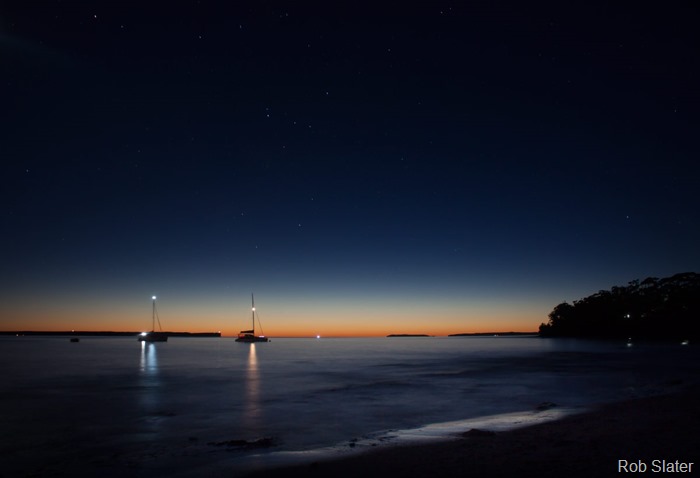 Through circumstance, good luck and public protest, we are able to enjoy Jervis Bay as nature intended. Through circumstance, good luck and public protest, we are able to enjoy Jervis Bay as nature intended. |
Headline to a story in the Canberra Times 1953.
Looking at these pictures it’s hard to imagine what all the fuss was about.
A different time, changing attitudes and old values sometimes don’t mix.
| A report that ‘Bikini’ swimsuits were “somewhat” in the vogue” at swimming resorts in Jervis Bay were made by the Jervis Bay Progress Association in a letter to the Advisory Council. Members felt that the ban applying on the majority of N.S.W beaches should apply at Jervis Bay. it was stated. “I bet all the members of this Progress Council are men, They are notoriously conservative.’ Mr Baily: All I can say is they must be old. Mr. Rogers said the Advisory Council might dodge this answer, the letter being addressed to the “Officer in Charge, Department of the Interior, Jervis Bay. The Council secretary. Mr G. Murphy, will inform the Association that the local policeman is the “responsible authority” for policing bathing costumes. |
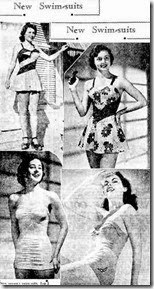 |  | Advertising from the period. |
| The story of seafaring along the east coast is awash with stories of hardship, despair and melancholy, but there are also stories of luck, near misses and close encounters. If the wind shifted, or the anchor did not take hold, or if the sea conditions changed for the worse, many close encounters could have turned into disaster. Starting off this series of “close encounters” is the story of the Barque Italy in 1877. | ||||
 | ||||
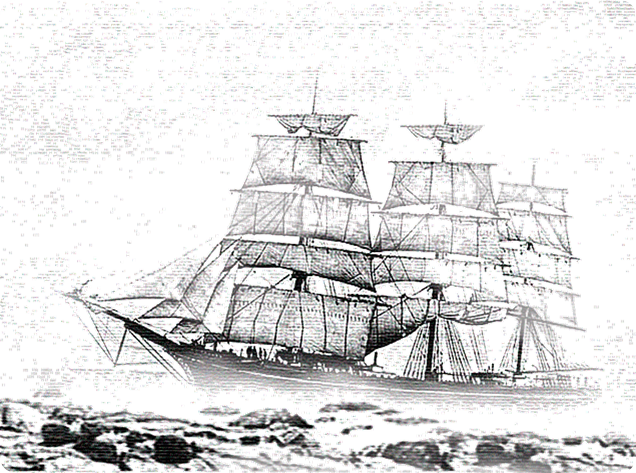 | ||||
| Reconstruction of the Barque Italy, enveloped in fog and ashore at Wreck Bay. | ||||
| As reported by Captain Rapp. Saturday 2nd June 1877. Sailed from Hobart Town on the morning of Saturday, 2nd instant. Had light variable winds with remarkable fine weather until Sunday morning. Sunday 10th. When the weather set in thick, foggy and showery, at intervals clearing a little (wind south) during the night. Monday 11th. 9am, on the 11th, sighted Pigeon House, the bearings agreeing with the reckoning. During the afternoon caught a glimpse of the land twice through the fog. At 1pm. a glimmer of light like a flash or revolving light to the south and westward, where we expected to see Jervis Bay light. We were then going at the rate of five or six knots, steering north1/2 east, wind south, veering to south west; had two men on the lookout forward. At 7p.m. the barque Adeline Burke, which vessel had been steering towards us from the eastward, was then nearly ahead. At 7.35 the second mate told me he saw land, and on looking saw land on the starboard beam; ordered the helm to be put starboard, but immediately after, hearing breakers and seeing land ahead, on the port side, I ordered and assisted to put the helm hard aport. Before the ship could answer her helm she struck on a flat out lying rock, turned off and forged partly over, hanging on it by her heel about fifty yards from shore. We had everything aback; waited sometime; found she would not move; stowed the sails and cleared the boats ready for lowering; sounded the pumps and found she was not making any water. The night being very dark and foggy we could not see any land, only rocks and breakers; lighted some touches and sent the second mate with three hands in the boat to make a line fast on shore on the port bow. At 11p.m. the ship heeled over much as the tide left her, wind and sea rising, with every indication of easterly weather; we all landed safely. Tuesday, 12th. At daylight, went on board, sounded the pumps, and noted our position; ran out kedge anchor and line; put out the long boat and laid out stream anchor and chain; got tent and stores on shore. Captain Rapp went in search of assistance; after three hours of fruitless travelling he returned on board; started again at 1pm, taking Mr. Wilson, the second mate and compass, making in a straight line for Cape St George lighthouse. 5 hours walking through dense scrub seeking assistance. After five hours’ walking through dense scrub, over hills, and through creeks and swamps, when within half-a-mile of the lighthouse, Captain Rapp, being unable to proceed further, sent the second mate on, who with Mr Gibson, the superintendant, returned; between them they managed to bring him to the lighthouse, where dry cloths and good treatment bought him around, and the following day with horses and a guide went back to the ship. | ||||
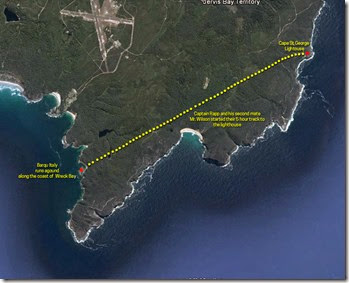 The walk for help. The walk for help. | ||||
| Wednesday, 13th. Put out springs and breastwarps; then began to lighten the ship; weather fine and sea smooth. Thursday, 14th. Fresh breezes and sea rising; hauled a longboat up a creek, and pumped the water out of the ship; weather looking threatening, landed some provisions. 8p.m. tide, wind, and sea rising, the ship went ahead on the rock into 12ft of water, parting all the wasps, only the stream anchor holding her; bumping very hard all night. Thursday, 14th. went on board at daylight, found 6ft of water in her, picked up the broken wasps and made all fast again then took to the pumps, employing some blackfellows to assist. 5p.m., reduced the water to two feet. The steamer Woniora coming to our assistance took her hawser; then commenced boating off the undamaged portion of the landed cargo. | ||||
11p.m, wind and sea rising, deeming it advisable to abandon the longboat, anchors, and other gear ; hove up the anchor, and towed to Sydney. Captain Rapp speaks highly of the kindness of Mr Gibson, the superintendent of the Jervis Bay lighthouse, and also of Mr. Lovegrove Shoalhaven, who was in assistance and gave all assistance in his powers. Meaning: Warp - A line or cable used in warping a ship. Stream Anchor - A light anchor for use with a bower in narrow waterways. Kedging or warping - Is a technique for moving or turning a ship by using a relatively light anchor. Kedge anchor - is an anchor carried in addition to the main. Aport - On or toward the port or left side of a ship. | ||||
 | ||||
| REF: Trove. http://trove.nla.gov.au/ndp/del/article/18820092 |
A dramatic headline, but that was how Jervis Bay was often described by early sailors and correspondents. Since the earliest recordings, sharks have always featured in writings about Jervis Bay.
Countless reports in regional newspapers attest to the excitement of shark encounters.
Sailors have always had an uneasy relationship with sharks, and non more so than the early sailors, and steam ship crews that plied along our coast.
I have found numerous reports of fishermen catching sharks in the 1800’s, and upon examination of their stomach contents, found, buttons and pieces of rotting cloths.
Fishing was mostly carried out on small timber launches. Jervis bay was seen as a “Fisherman’s Paradise”Below are just a few of the more interesting examples of stories that appear in newspapers all over the country. There are many more. . 1886. Evidence of a man eater.
A correspondent of the “Colonist” writes:
Mr G. Dent, snr, on Saturday last, caught a shark of the Blue Pointer species, measuring 10ft, in length. Upon opening the monster, Mr Dent was surprised to find a pair of boots and a pair of trousers inside.
Making light of the situation the correspondent goes on to say.
” We have often heard of persons finding their cloths gone after coming from bathing, and being unable to trace the thief. Perhaps this shark incident explains it. Still one can hardly understand the shark leaving the bather and taking his cloths.1893. Disecting Sharks
An article in the Sydney Morning Herald about fishing in Jervis Bay goes on to explain the practice of dissecting sharks.
”Everyone, and more especially sailors, love to see a shark caught, and as a general rule they are dissected to discover what they have been eating last. Sometimes there are buttons, or hideously suggestive fragments of clothing, fortunately we did not come across any traces of man eating”.1914. Shooting Sharks. The Evening News Sydney. These images appeared in the Sydney Mail 1926. This photo appears to be taken inside Honeymoon Bay, a popular spot for fishermen to seek shelter. The story of Sydney fishermen on a trip to Jervis Bay.
“While out fishing on a sandy bottom for whiting, were surprised to see the water simply swarming with sharks. Fishing under the circumstances was out of the question so the launch returned to the shore. Two rifles, and a couple of harpoons were secured, and the boat returned to the shark infested spot.When a large shark rose to the surface two shots were fired at it, after dashing around in a circle, the wounded brute came close to the launch, again, when the harpoon was embedded in it’s side. The shark did not put up much of a struggle”. This pattern went on all day until the tally of sharks accounted to no fewer than thirty. A typical early fishing party at rest in Honeymoon Bay.
Doesn’t everyone fish in a suit and tie?1925. Capture of a shark at Jervis Bay.
Cootamundra Herald.
This story is about a couple from Wagga who had just returned from a holiday at Jervis Bay.
“Standing on the beach watching a number of fishermen hauling in their nets, when a large shark was seen to break through the nets, and it became stranded amongst the breakers on the beach. After much struggling, and telling how the shark lunged at their legs causing great excitement, they lashed the tail with a rope and hauled the shark on shore, tied it to a tree overnight, next day it was discovered to be a 9ft Whaler, with jaws 21inches across.
Early Huskisson wharf, this shark attracted quite a crowd.1937. DRUM FISHING. The Shoalhaven News.
A story appears about Reg Jarman and S. Parnell using heavy lines set to oil drums for a float, “it didn’t take them long to land three blue pointers – one 5ft, one 8ft, and one 9ft”.The slaughter of the Grey Nurse shark. Large hauls, up to 30 sharks at a time have been reported, mainly used for their oil, fishermen knew where to find them, and how to catch this slow moving beautiful harmless creature.
Grey Nurse Shark Catch, Currarong NSW.
Wollongong City Library.
By 1937. A big game fishing angling club
Was established at Huskisson. Tournaments attracted anglers from all over the country.
“The visit of so many head-liners of the angling world was very gratifying” - sharks were an easy target and put up a good fight.1953. “Bikini’s and sharks disturb Jervis Bay. Canberra Times.
The bikini part of the headline, referred to an amusing story about the trends in swimming attire, and the angst they were causing in Jervis Bay. I will post that as a separate article in the future.Shark Net Beach.
Because of complaints at the amount of sharks seen in Jervis Bay and the common fear that comes with such creatures, a large shark net barrier was suspended across the small beach that became known as “Shark Net Beach”, Remnants in the form of large concrete supporting blocks can still be seen on either side of the beach today.
The story continued:
”Sharks have again invaded the swimming pool, according to the second letter from the association.
The association complained that the pool had not been cleaned out, and the gap in the net not mended, despite promises by the council 12 months ago.
The association claimed a shark 7ft long, swam into the pool recently.Many large sharks have been captured. 1937, White Death.
‘Another fishing record was created at Jervis Bay last Saturday night, Milton Kent, well known Sydney airman and big game fisherman landed a 1000lb white pointer shark, after a fight lasting 4 hours and 40 minutes.
1928. Torpedo hits shark.
One of the more unusual stories appeared in the Northern Standard. Darwin.
”A shark was struck by a torpedo fired from the Cruiser ‘Sydney” at Jervis Bay and lost it’s tail. When it was struck it swam in a circle several times leaving a trail of blood. The tail was later seen floating on the surface of the ocean.
With a small amount or research one can find numerous stories in old papers about sharks, shark fishing and close encounters in Jervis Bay.
These days most sharks that are caught in our local waters are tagged and let go, occasionally someone will bring in one of these magnificent creatures to hang on the scales at Huskisson wharf. This practice still draws a crowd, fascinated by these denizens of the deep.1918 An old time swimmers miraculous adventure.
OUT OF THE JAWS OF DEATH.
The late Henry Gordon of Nowra N.S.W is credited with winning the first swimming race in Australia had a lucky escape from death while swimming in Jervis Bay.
One of his exploits was to swim across the mouth of the Shoalhaven river and back with one of his boy’s on his back.
This day in Jervis Bay, while going for a dip.
He swam out half a mile and on the return swim and within 20 yards or so of the shore, he saw and heard a great commotion among the blackfellows on the beach,
They were shouting out and gesticulating in a most excited way, and Mr. Morton at once jumped to the conclusion that a shark was after him. He at once made frantic efforts to reach the landing-place, but before he could get there a huge shark bore down upon him
And then a miraculous thing happened, which almost passes belief. So fierce was the rush of the shark after it’s intended prey that the speed it attained proved the swimmer’s salvation.
The onward rush of the monster carried it past the swimmer as he was just a few feet from the rock where he was trying to land, and it landed high and dry out of the water. As it dashed past the swimmer it scraped his thigh, the marks of which he carried with him his to his grave. While the stranded shark was withering to get back into it’s native element the startled swimmer was able to clamber out safely. The shark measured about 20ft in length, and the swimmers escape was one of the most remarkable on record.
The mirror Feb 1918.
In 1921, an Arial survey was commissioned from Sydney to the Victorian boarder, the main stretches photographed, and places suitable for the establishment of aerodromes marked.
During this trip the little sea plane known as the “Sea Gull” landed on Jervis Bay or “the Ditch” as it was described by Napier Lion and his partner Shellback.
He describes his delight at seeing Huskisson for the first time.
The following day they ran the nose of their aircraft onto the spit opposite Huskisson to the delight of the gathering crowd. The sea gull crew then took their ‘live freight” for scenic flights over the bay. 
Supported and accompanied by the sailing vessel the “Acielle” she carried supplies and repair equipment, it was decided to bring the plane into Currambene creek and onto the government slipway for inspection, astonished to find the hull covered in barnacles' they used petrol and elbow grease to clear the growth before applying new varnish.
He describes his slight encounter with a fishing vessel that might have damaged the plane and the effort required to get it ready for flight.
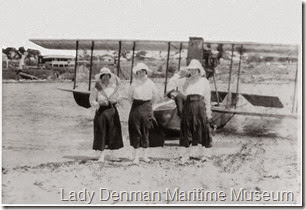
Time to leave the bay.
Ready to get back into the air, Napier describes the difficulty they experienced with the tide “the tide was running at an absolute banker” getting stuck on the spit, and going to great physical effort to get her floated and into the air for the next part of the journey.
He describes running into a fog bank south of the bay and flying close to the cliffs and as low as 50ft over the ocean to clear the fog.
The whole story of their time at Huskisson makes great reading, you can see the story by clicking on the link here.
http://trove.nla.gov.au/ndp/del/page/16898017